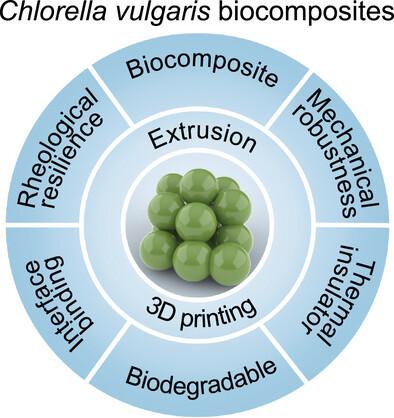当前位置:
X-MOL 学术
›
Adv. Mater.
›
论文详情
Our official English website, www.x-mol.net, welcomes your
feedback! (Note: you will need to create a separate account there.)
Multifunctional Biocomposite Materials from Chlorella vulgaris Microalgae
Advanced Materials ( IF 27.4 ) Pub Date : 2024-11-19 , DOI: 10.1002/adma.202413618 Israel Kellersztein, Daniel Tish, John Pederson, Martin Bechthold, Chiara Daraio
Advanced Materials ( IF 27.4 ) Pub Date : 2024-11-19 , DOI: 10.1002/adma.202413618 Israel Kellersztein, Daniel Tish, John Pederson, Martin Bechthold, Chiara Daraio

|
Extrusion 3D‐printing of biopolymers and natural fiber‐based biocomposites enables the fabrication of complex structures, ranging from implants' scaffolds to eco‐friendly structural materials. However, conventional polymer extrusion requires high energy consumption to reduce viscosity, and natural fiber reinforcement often requires harsh chemical treatments to improve adhesion. We address these challenges by introducing a sustainable framework to fabricate natural biocomposites using Chlorella vulgaris microalgae as the matrix. Through bioink optimization and process refinement, we produced lightweight, multifunctional materials with hierarchical architectures. Infrared spectroscopy analysis reveals that hydrogen bonding plays a critical role in the binding and reinforcement of Chlorella cells by hydroxyethyl cellulose (HEC). As water content decreases, the hydrogen bonding network evolves from water‐mediated interactions to direct hydrogen bonds between HEC and Chlorella , enhancing the mechanical properties. A controlled dehydration process maintains continuous microalgae morphology, preventing cracking. The resulting biocomposites exhibit a bending stiffness of 1.6 GPa and isotropic heat transfer and thermal conductivity of 0.10 W/mK at room temperature, demonstrating effective thermal insulation. These characteristics make Chlorella biocomposites promising candidates for applications requiring both structural performance and thermal insulation, offering a sustainable alternative to conventional materials in response to growing environmental demands.
中文翻译:

来自小球藻微藻的多功能生物复合材料
生物聚合物和天然纤维基生物复合材料的挤出 3D 打印能够制造复杂的结构,从植入物的支架到环保的结构材料。然而,传统的聚合物挤出需要高能耗来降低粘度,而天然纤维增强通常需要苛刻的化学处理来提高附着力。我们通过引入可持续框架来应对这些挑战,以小球藻微藻为基质制造天然生物复合材料。通过生物墨水优化和工艺改进,我们生产了具有分层架构的轻质多功能材料。红外光谱分析表明,氢键在羟乙基纤维素 (HEC) 对小球藻细胞的结合和强化中起着关键作用。随着含水量的降低,氢键网络从水介导的相互作用演变为 HEC 和小球藻之间的直接氢键,从而增强了机械性能。受控的脱水过程保持连续的微藻形态,防止开裂。所得生物复合材料在室温下表现出 1.6 GPa 的弯曲刚度和 0.10 W/mK 的各向同性传热和导热率,显示出有效的隔热效果。这些特性使小球藻生物复合材料成为需要结构性能和隔热性的应用的有希望的候选者,为响应不断增长的环境需求提供了传统材料的可持续替代品。
更新日期:2024-11-19
中文翻译:

来自小球藻微藻的多功能生物复合材料
生物聚合物和天然纤维基生物复合材料的挤出 3D 打印能够制造复杂的结构,从植入物的支架到环保的结构材料。然而,传统的聚合物挤出需要高能耗来降低粘度,而天然纤维增强通常需要苛刻的化学处理来提高附着力。我们通过引入可持续框架来应对这些挑战,以小球藻微藻为基质制造天然生物复合材料。通过生物墨水优化和工艺改进,我们生产了具有分层架构的轻质多功能材料。红外光谱分析表明,氢键在羟乙基纤维素 (HEC) 对小球藻细胞的结合和强化中起着关键作用。随着含水量的降低,氢键网络从水介导的相互作用演变为 HEC 和小球藻之间的直接氢键,从而增强了机械性能。受控的脱水过程保持连续的微藻形态,防止开裂。所得生物复合材料在室温下表现出 1.6 GPa 的弯曲刚度和 0.10 W/mK 的各向同性传热和导热率,显示出有效的隔热效果。这些特性使小球藻生物复合材料成为需要结构性能和隔热性的应用的有希望的候选者,为响应不断增长的环境需求提供了传统材料的可持续替代品。


















































 京公网安备 11010802027423号
京公网安备 11010802027423号